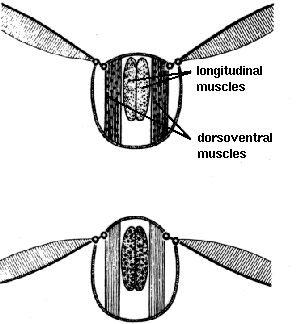 The Evolution of Flight
The Evolution of Flight
The Flight Muscles
The Indirect Muscle System
The muscles in this system are not attached to the wings. The figure shows the
double-hinged attachment of the wings to the thorax, one hinge being connected to the side of the
thorax and the other to the tergum. The dorsoventral muscles, running from the tergum
to the bottom of the thorax, contract to raise the wings. The longitudinal muscles,
running along the length of the thorax, contract to lower the wings. When the dorsoventral muscles
 contract, the tergum is lowered and the wings rotate about the outer hinges and rise. When the
longitudinal muscles contract, the tergum is forced upward again, and the wings rotate in the opposite
sense about the outer hinges.
contract, the tergum is lowered and the wings rotate about the outer hinges and rise. When the
longitudinal muscles contract, the tergum is forced upward again, and the wings rotate in the opposite
sense about the outer hinges.
The effect of the indirect musculature may be described by a familiar object: the tennis ball. If two
pins are stuck into the upper hemisphere of the ball to represent the wings, then compressing the ball
vertically flattens the top and bottom of the sphere and pushes the equator outward. This change in the
shape of the tennis ball results in the pins moving upward. If the ball is now squashed at the back
and front, then flattening occurs at the back and the front of the ball, and the top and bottom are
pushed out. In this case, the pins rotate downward.
The housefly and other Diptera, for example, employ this musculature. The benefit of the indirect
muscle system is that it allows much more rapid beating. Gnats can flap their wings up to 1000 times in
a second, and houseflies commonly around 200. The synchronization of the wings is easier to accomplish
because the tergum causes both wings to move at the same time as it pulses in and out. The muscles
themselves require few orders from the brain. The brain only needs to instruct them to start or stop
flapping or to somehow modify the beating of the wings during flight. The muscles maintain the rhythm
of contractions on their own, continuing to contract in the right coordination until told to do otherwise
by the brain. Thus it is that the brain has less work to do to control the flight and the insect can
beat its wings very quickly.

 The Evolution of Flight...4, March 1996
The Evolution of Flight...4, March 1996
 contract, the tergum is lowered and the wings rotate about the outer hinges and rise. When the
longitudinal muscles contract, the tergum is forced upward again, and the wings rotate in the opposite
sense about the outer hinges.
contract, the tergum is lowered and the wings rotate about the outer hinges and rise. When the
longitudinal muscles contract, the tergum is forced upward again, and the wings rotate in the opposite
sense about the outer hinges.
 The Evolution of Flight
The Evolution of Flight
 The Evolution of Flight...4, March 1996
The Evolution of Flight...4, March 1996